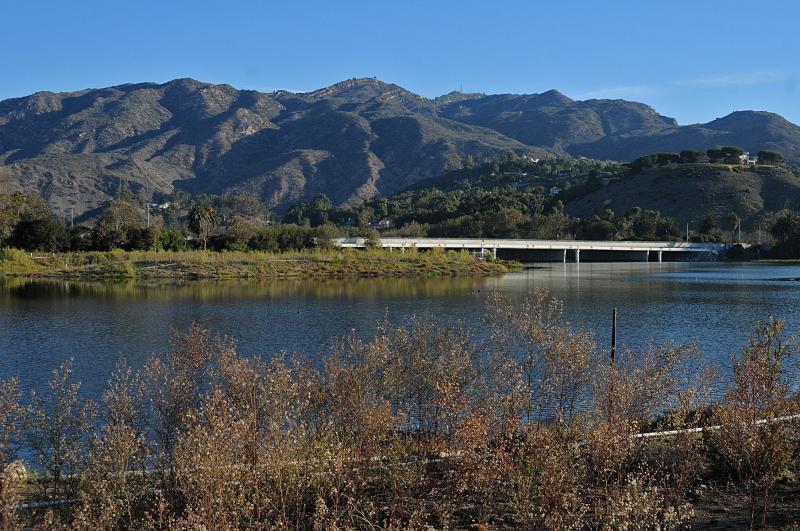 |
| The hillside ridge, as seen from Malibu lagoon, where musician David Evans wants to build five mansions on sensitive coastal habitat. The Sierra Club opposes the project. Photo credit: Jim Kenney |
Plans for a development that would place super-sized mansions on Malibu hillsides by U2 musician David Evans (a.k.a. the Edge) are strongly opposed by Sierra Club, environmental groups and public agencies. The Sweetwater Mesa project, as its called, in the Santa Monica Mountains will forever change the profile of the ridgelines and impact environmentally sensitive areas. The plan will come up for a vote by the California Coastal Commission an upcoming meeting (no exact date has yet been given).
The development goes up against California Coastal Act rules and violates portions of L.A. County's recently certified Local Coastal Draft Plan. The Club opposes the project that will rip through designated sensitive habitat land and heavily grade massive areas of the hillsides. The proposal calls for five mansions, pools, driveways and associated out-buildings located along 3,000 feet of what's designated as a "significant ridgeline." The land also is well-documented as an area with earthquake faults and high fire danger locations.
Sited in the Santa Monica Mountains
The Santa Monica Mountains National Recreational Area is a very special place and is one of the greatest urban parks in the country. Roughly 54% of the 160,000 acres is public or otherwise protected open space. But lacking funds to buy all the parkland, scenic viewsheds, habitat linkages, watersheds and trail corridors that need protection, it's imperative that the protective policies of the California Coastal Commission and and the Los Angeles County Coastal Coastal Plan be used as enforcement.
The common goals are resource protection and preservation, public access, enjoyment and safety; these goals take priority over development in the Santa Monica Mountains and within the Coastal Zone.The project proposed by the Edge in Malibu is inconsistent with the California Coastal Act (specifically these sections, if you want to look them up: 30240; 3250;30251; 30253 and numerous policies in the County's plan dealing with H1 habitat. It is inconsistent in regard to grading and geology, visual impacts, environmentally sensitive habitat areas (ESHA), water lines, hazards and cumulative impacts. The destruction of habitat has not been minimized.
What's wrong with the plan? Everything
Grading: Grading for the project is massive, nearly 42,000 cubic yards (28,720 cubic yards to be cut, 1,490 cubic yards to fill in). It would be a major disruption of the existing landscape.
Landslide area: The structures, swimming pools, garages and driveways and the entrance road are slated to be built in areas of mapped landslides. In addition, there will be a16.5-foot-high mesh rockfall stabilization device running more than 300 feet across the hillside.
Road grading and building: Grading of a 2,000-plus foot road is required to access the proprieties, and compounds the already huge footprint, along with accessory uses such as lighting, pets, and required brush clearance of large land areas. The overall size and grading is not consistent with the requirements of the Coastal Act to minimize grading and avoid locating structures on known geologic hazards and known landslides. This project is incompatible with its presence in the National Recreation Area.
Viewshed: And then there's what's called visual degradation of the area. The Coastal Commission Staff admits the project will have impacts that are "unmitigatable" on public views. The proposed five mansions and their associated outbuildings are within the view site of this designated "significant ridgeline" along the Malibu coast. Placement of these homes would have a jarring visual impact. Also the height limit is not to exceed 18 feet above grade, but at least one of the structures exceed this limitation.
Fire zone: The entire area has a history of wildfires, and structures built will require extensive resources for fire protection, costly and dangerous for both residents and firefighters.
Ecological issues: The land to be developed in this project is comprised of pristine native chaparral, coastal sage scrub and oak woodland habitat with ESHA designation. It is surrounded by some 28,000 acres of undisturbed native habitat. This habitat sustains mountain lions, coyotes, bobcats and other animals who need large undisturbed blocks of habitat to survive.This core habitat area will be severely impacted by development.
Growth inducement: Installation of a 7,800-foot water line with a capacity for connecting to adjacent undeveloped properties provides infrastructure that encourages additional development. Core habitat will be cut into pieces by the long water line, access road and brush clearance.Trenching and installation and maintenance of the waterline significantly impacts this presently undisturbed area and is inconsistent with the L.A.
How you can help
Join us when this comes up at the Coastal Commission meeting and make your voice heard. Let the board know that you oppose the project to protect our ever-vanishing coast.